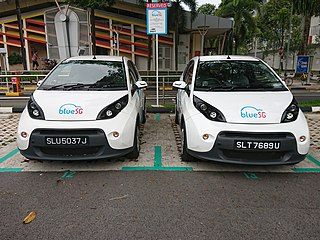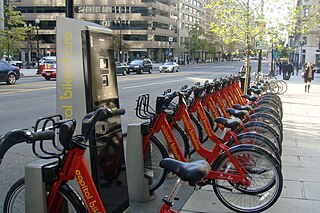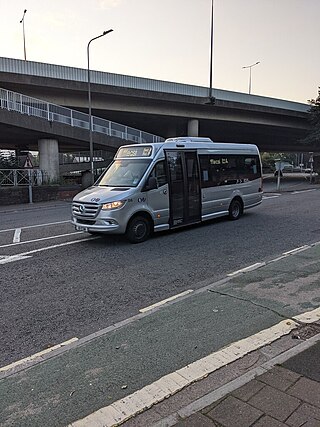
A self-driving car, also known as an autonomous car (AC), driverless car, robotaxi, robotic car or robo-car, is a car that is capable of operating with reduced or no human input. Self-driving cars are responsible for all driving activities, such as perceiving the environment, monitoring important systems, and controlling the vehicle, which includes navigating from origin to destination.

Carsharing or car sharing or car clubs (UK) is a model of car rental where people rent cars for short periods of time, often by the hour. It differs from traditional car rental in that the owners of the cars are often private individuals themselves, and the car sharing facilitator is generally distinct from the car owner. Car sharing is part of a larger trend of shared mobility.

Teleoperation indicates operation of a system or machine at a distance. It is similar in meaning to the phrase "remote control" but is usually encountered in research, academia and technology. It is most commonly associated with robotics and mobile robots but can be applied to a whole range of circumstances in which a device or machine is operated by a person from a distance.
Vehicular communication systems are computer networks in which vehicles and roadside units are the communicating nodes, providing each other with information, such as safety warnings and traffic information. They can be effective in avoiding accidents and traffic congestion. Both types of nodes are dedicated short-range communications (DSRC) devices. DSRC works in 5.9 GHz band with bandwidth of 75 MHz and approximate range of 300 metres (980 ft). Vehicular communications is usually developed as a part of intelligent transportation systems (ITS).

Transportation demand management or travel demand management (TDM) is the application of strategies and policies to increase the efficiency of transportation systems, that reduce travel demand, or to redistribute this demand in space or in time.

Vehicular automation involves the use of mechatronics, artificial intelligence, and multi-agent systems to assist the operator of a vehicle such as a car, lorry, aircraft, or watercraft. A vehicle using automation for tasks such as navigation to ease but not replace human control, qualify as semi-autonomous, whereas a fully self-operated vehicle is termed autonomous.

Shared transport or shared mobility is a transportation system where travelers share a vehicle either simultaneously as a group or over time as personal rental, and in the process share the cost of the journey, thus purportedly creating a hybrid between private vehicle use and mass or public transport. It is a transportation strategy that allows users to access transportation services on an as-needed basis. Shared mobility is an umbrella term that encompasses a variety of transportation modes including carsharing, Bicycle-sharing systems, ridesharing companies, carpools, and microtransit.

Waymo LLC, formerly known as the Google Self-Driving Car Project, is an American autonomous driving technology company headquartered in Mountain View, California. It is a subsidiary of Alphabet Inc.

In supply chain management and transportation planning, the last mile or last kilometer is the last leg of a journey comprising the movement of passengers and goods from a transportation hub to a final destination. The concept of "last mile" was adopted from the telecommunications industry, which faced difficulty connecting individual homes to the main telecommunications network. Similarly, in supply chain management, last-mile describes the logistical challenges at the last phase of transportation getting people and packages from hubs to their final destinations.

Experiments have been conducted on self-driving cars since 1939; promising trials took place in the 1950s and work has proceeded since then. The first self-sufficient and truly autonomous cars appeared in the 1980s, with Carnegie Mellon University's Navlab and ALV projects in 1984 and Mercedes-Benz and Bundeswehr University Munich's Eureka Prometheus Project in 1987. In 1988, William L Kelley patented the first modern collision Predicting and Avoidance devices for Moving Vehicles. then, numerous major companies and research organizations have developed working autonomous vehicles including Mercedes-Benz, General Motors, Continental Automotive Systems, Autoliv Inc., Bosch, Nissan, Toyota, Audi, Volvo, Vislab from University of Parma, Oxford University and Google. In July 2013, Vislab demonstrated BRAiVE, a vehicle that moved autonomously on a mixed traffic route open to public traffic.
A robotaxi, also known as robot taxi, robo-taxi, self-driving taxi or driverless taxi, is an autonomous car operated for a ridesharing company.
Mobility as a service (MaaS) is a type of service that enables users to plan, book, and pay for multiple types of mobility services through a combined platform. Transportation services from public and private transportation providers are combined through a unified gateway, usually via an app or website, that creates and manages the trip and payments, including subscriptions, with a single account. The key concept behind MaaS is to offer travelers flexible mobility solutions based on their travel needs, thus "mobility as a service" also refers to the broader concept of a shift away from personally-owned modes of transportation and towards mobility provided as a service.
Kara M. Kockelman, Ph.D., P.E. is an American civil and transportation engineer, who is currently the Dewitt Greer Centennial Professor of Transportation Engineering at the University of Texas at Austin, previously the Clare Boothe Luce Professor of Civil Engineering, and a published author. Kockelman’s work focuses on transportation, and includes planning for future implementation of shared and autonomous vehicle systems, and policies like credit-based congestion pricing and urban growth boundaries.
Torc Robotics (Torc), an independent subsidiary of Daimler Truck, is an American autonomous truck company headquartered in Blacksburg, Virginia, with operations in Albuquerque, New Mexico; Austin, Texas; and Stuttgart, Germany. Torc is testing autonomous trucks in Virginia, New Mexico, and Texas and is taking a pure play approach to commercialization – focusing at first on one platform in one region.

Microtransit is a form of bus demand responsive transport vehicle for hire. This transit service offers a highly flexible routing and/or highly flexible scheduling of minibus vehicles shared with other passengers. Microtransit providers build routes ad-hoc exclusively to match only each demand (trip) and supply and to extend the efficiency and accessibility of the transit service. Possible pick-up/drop-off stops are restricted, and transit can be provided as a stop-to-stop service or a curb-to-curb service.
Cruise LLC is an American self-driving car company headquartered in San Francisco, California. Founded in 2013 by Kyle Vogt and Dan Kan, Cruise tests and develops autonomous car technology. The company is a largely autonomous subsidiary of General Motors. Following a series of incidents, it suspended operations in October 2023, and Kyle Vogt resigned as CEO in November 2023,. Still, the company began returning its vehicles to public roads in May 2024.

A self-driving truck, also known as an autonomous truck or robo-truck, is an application of self-driving technology aiming to create trucks that can operate without human input. Alongside light, medium, and heavy-duty trucks, many companies are developing self-driving technology in semi trucks to automate highway driving in the delivery process.
Drive.ai, a subsidiary of Apple Inc., is an American technology company headquartered in Mountain View, California that uses artificial intelligence to make self-driving systems for cars. It has demonstrated a vehicle driving autonomously with a safety driver only in the passenger seat. To date, the company has raised approximately $77 million in funding. Drive.ai's technology can be modified to turn a vehicle autonomous.
The impact of self-driving cars is anticipated to be wide-ranging in many areas of daily life. Self-driving cars have been the subject of significant research on their environmental, practical, and lifestyle consequences and their impacts remain debated.
Regulation of self-driving cars, autonomous vehicles and automated driving system is an increasingly relevant topic in the automotive industry strongly related to the success of the actual technology. Multiple countries have passed local legislation and agreed on standards for the introduction of autonomous cars.












